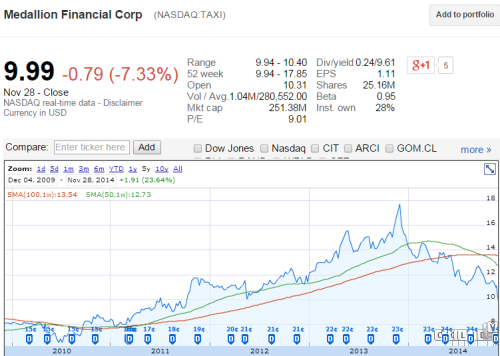From the latest NYT article (link), the average price of an individual taxi medallion is plummeting across major cities throughout US.
- NYC: fell to $872K in October – down 17% from a peak (over $1M) reached in spring of 2013
- Chicago: down 17%, averaged $298K in Nov, below $357K earlier in Spring
- Boston: down at least 20%, in April, one was asking for $700K. Last sale in Oct was for $561K
- Philadelphia: $475K asking price has no bidder, it will try again at $350K
Who to Blame? Uber?
Medallion system was established in New York in 1937 to limit the number of operating taxicabs. At that time, the number is 13,347. Believe it or not, 78 years later the number only increased by 1.25% to 13,605 (as of March 14 2014 – Wikipedia) with 51,938 men and women drivers in US.
Second issue is pricing.
“I’m already at peace with the idea that I’m going to go bankrupt,” said Larry Ionescu, who owns 98 Chicago taxi medallions. (source: NYT)
If Uber is that much cheaper than a taxi, why would anyone take a taxi, and therefore why would any driver pay to lease a medallion? The Chicago medallions operator says his revenues are down around 25 percent, and he’s having trouble leasing out his whole fleet.
How Much Cheaper? Uber vs. Taxi Cab
From a recent article reported by Business Insider on Oct 29, 2014 (link), more than dozen of NYC yellow taxi drivers revealed that they’re making anywhere from $5 an hour to $20 an hour as opposed to what Uber publishes in their fact sheet saying that driver could earn $25.67 on average.
For comparison, a NYC Yellow Cab earns $25 — $30 per hour net of gas and fees (referenced from the TLC’s Taxicab Fact Book below). Therefore, Uber is about 50% cheaper.
Since I live in Greater Boston, I tried to further research how fare compares on whatsthefare.com for leaving from the Braintree South Shore Mall to Boston Logan Airport around 6pm on Sat. You can see fare estimates of UberX and Lyft are both 50% or more lower than regular taxi fare.
Uber itself is also facing intense competition from Lyft, SideCar, and few others. This summer Uber introduced 20% discount as a short-term plan to boost demand and awareness. But in September, Uber extended its discounted UberX fares indefinitely.
Discount is always great news for consumers as it means taking an UberX would cost less than taking a taxi. But for UberX drivers, it was not so great. No surprise that taxi drivers acrorss US protested against transportation network companies for unfair business ethics.

Shorting TAXI to Bet On UBER
While Uber is hitting a $17 billion (rumor to be $20B) enterprise valuation after raising a $1.2B round in the summer, Hertz considered partnering with Uber. The falling taxi medallion price is also confirming the unstoppable bullish trend for the ride-sharing company.
I was seriously thinking about how to bet on blooming interest in Uber through the public market. One way was to short Medallion Financial (TAXI).
Medallion Financial is a financier originating and servicing loans (mostly in NYC) to purchase city-issued “medallions” required to operate yellow cabs – which is down 25% YTD as of Nov 26th, and about 40% Y/Y as short-sellers have rushed in.
From a WSJ article on Jun 19: “The medallion’s monopoly on gaining entry to the New York taxi market looks set to weaken in the coming years as companies such as Uber and Lyft start to provide digital competition to their old-school peers for their share of the taxi world,” says Markit analyst Simon Colvin.
After the sharp decline in early 2014, I would argue that if TAXI share price continues to decline further to 2010 level, it may instead become attractive med-term investment with almost 10% dividend yield. [Please do your own research before making any trades]
Conclusion
The taxi industry is permanently disrupted by ride-sharing start-ups like brick and mortar retail disrupted by giant discount store – WalMart many years ago. Some people say Uber is a law-breaking, tax-evading monopoly-like mega-corporation but one can also argues that those taxi medallions are only cash cow for local municipals and are against our free competition virtue in a capitalist society.
I think it all depends on whether you stands into the taxi driver’s or the consumer’s shoes. If we look at history, consumer demand ultimately drove the uprising and monopoly of Walmart until Amazon, eBay, or other online retail emerged 15 years ago. Walmart is still big now but no longer a monopoly. Perhaps the same history will exist for ride-sharing companies. Who knows.




